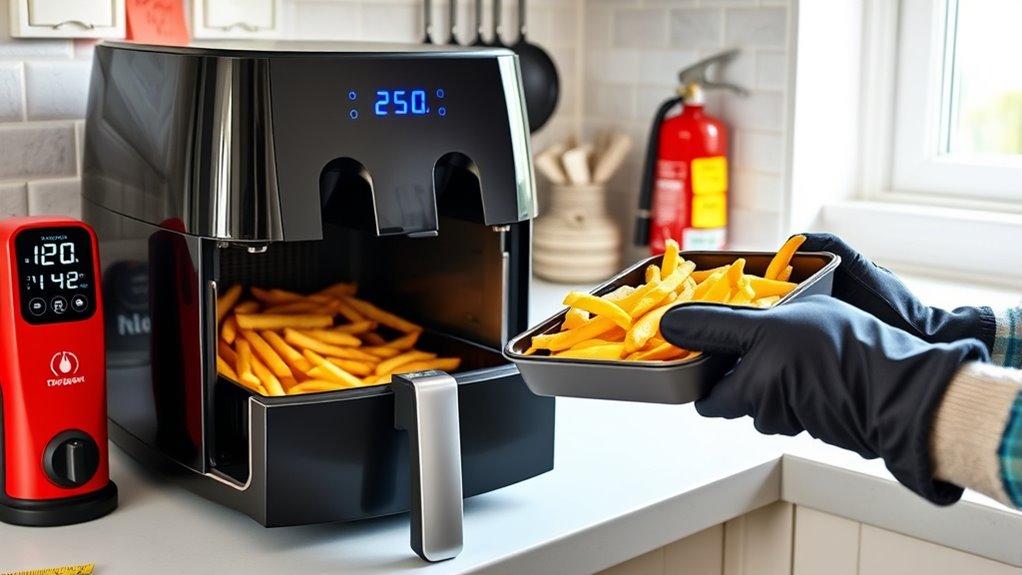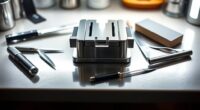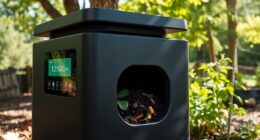To ensure safe air fryer use, always place it on a stable, heat-resistant surface and keep it well-ventilated with at least 15cm clearance around it. Keep the top clear of items to avoid blocking vents, and don’t overfill the basket—limit to 75% capacity and arrange food in a single layer. Regularly clean the basket and coils, use appropriate liners, and be cautious with oily or fatty foods to prevent flare-ups. Knowing how to respond in emergencies can protect you; more safety tips follow.
Key Takeaways
- Place the air fryer on flat, heat-resistant surfaces with at least 15cm clearance for proper ventilation and safety.
- Never overfill the basket beyond 75%, and arrange food in a single layer for even cooking and safety.
- Keep the top of the air fryer clear of objects to prevent blockage of vents and heat buildup.
- Regularly clean the basket and wipe heating coils to prevent grease accumulation and fire hazards.
- Unplug immediately if a fire occurs; use a fire extinguisher suitable for electrical fires and avoid water.
Place Your Air Fryer on a Stable, Heat-Resistant Surface
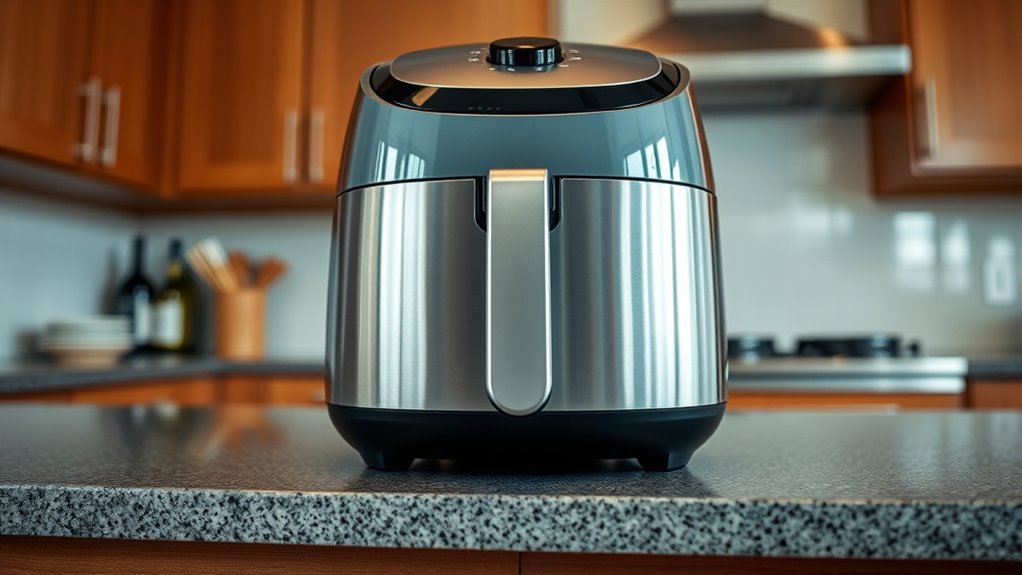
To guarantee safe and efficient air frying, you should place your air fryer on a flat, stable, and heat-resistant surface. This ensures safety by preventing wobbling or tipping during operation, which could cause accidents or spills. Choose materials like stone, tile, or solid wood that can withstand high temperatures without damage. An unstable or uneven surface might restrict airflow, leading to overheating and potential safety hazards. Keep in mind that the exterior of the air fryer can get very hot, so the surface must be heat-resistant to avoid damage or fire risks. Placing your air fryer on a stable, heat-resistant surface not only protects your appliance but also promotes safe cooking practices and prevents unintended accidents. Additionally, home safety practices recommend ensuring the area around your air fryer is clear of clutter to minimize fire risks. Being aware of angel numbers and their messages can also serve as a reminder to stay attentive and cautious while cooking. Proper placement also helps maintain optimal airflow, which is crucial for even cooking and appliance longevity. Ensuring your surface is level also helps prevent the appliance from tipping over during use, and a stable placement can help maximize retirement planning principles like reducing risks and ensuring consistent performance.
Maintain Proper Ventilation and Clearance

Make sure there’s at least 15cm of space around your air fryer to allow proper airflow. Keep it away from walls and avoid placing objects on top that could block vents. Regularly check that the area stays clear and free of obstructions to prevent overheating. Being aware of your essential oil safety options can also inspire you to create delicious, healthy treats at home. Additionally, understanding juice detox side effects can help you plan safe and effective cleansing routines. Proper air circulation is essential for preventing heat buildup and ensuring the longevity of your appliance. Incorporating AI-powered monitoring devices can further help track ventilation conditions and alert you to potential issues before they occur.
Keep Clear Surroundings
Maintaining proper ventilation and clearance around your air fryer is essential for safe and efficient operation. To keep clear surroundings, ensure there’s at least 6 inches of space between the appliance and walls or cabinets. This promotes good airflow, helping prevent overheating and guaranteeing ideal air fryer safety. Avoid placing objects on top of your air fryer, such as paper towels or cookbooks, as these can block heat escape vents and pose a fire risk. Always position the fryer on a flat, stable surface that allows for adequate ventilation on all sides. After each use, double-check that the area around your air fryer remains clear. Keeping your surroundings free of obstructions reduces safety hazards and keeps your air fryer functioning smoothly. Additionally, understanding the best heat pump features can help ensure your kitchen remains comfortable and energy-efficient during use. Proper kitchen safety practices also include regular cleaning and inspecting your appliance for any signs of damage. Being aware of airflow requirements can further enhance the safety and longevity of your device. Regularly reviewing your ventilation setup can help you identify potential issues before they become safety concerns.
Avoid Overhead Obstructions
Ensuring proper airflow around your air fryer requires keeping at least 15 centimeters (6 inches) of space between the appliance and overhead cupboards. This clear space allows ventilation to work effectively and prevents heat buildup. Avoid placing objects like paper towels, cookbooks, or containers on top of the air fryer basket, as they block vents and restrict airflow. When ventilation is obstructed, heat can accumulate, increasing the risk of overheating or fire. To maintain safety and extend your air fryer’s lifespan, regularly check that nothing is stored or resting on top. Proper clearance and ventilation keep your appliance cool and functioning best. Additionally, understanding the importance of proper ventilation practices can help prevent potential hazards and ensure your appliance operates safely. Recognizing air fryer safety standards can also help you stay aware of potential safety guidance related to your appliance. Keeping up with technological safety standards is essential for safe appliance use. Regular maintenance and tuning of your air fryer can also optimize its performance and safety features.
Keep the Top of the Air Fryer Clear of Items

Since the top of your air fryer contains essential ventilation vents, it’s important to keep that area clear of any items. These vents release hot air during cooking, and blocking them can disrupt air circulation, causing the appliance to overheat. Placing objects like paper towels, cookbooks, or containers on top can obstruct airflow, reducing efficiency and increasing fire risk. When airflow is blocked, heat builds up inside, which can damage internal components and shorten the air fryer’s lifespan. Proper air circulation is critical for efficient cooking and safety. Ensuring unobstructed vents also helps prevent overheating and potential hazards, maintaining optimal performance. Additionally, ventilation efficiency depends on unobstructed vents, ensuring the appliance operates at optimal temperatures and performance. Regularly inspecting and cleaning the vents can help maintain proper airflow and extend the appliance’s durability.
Use Suitable Accessories and Liners for Easy Cleaning
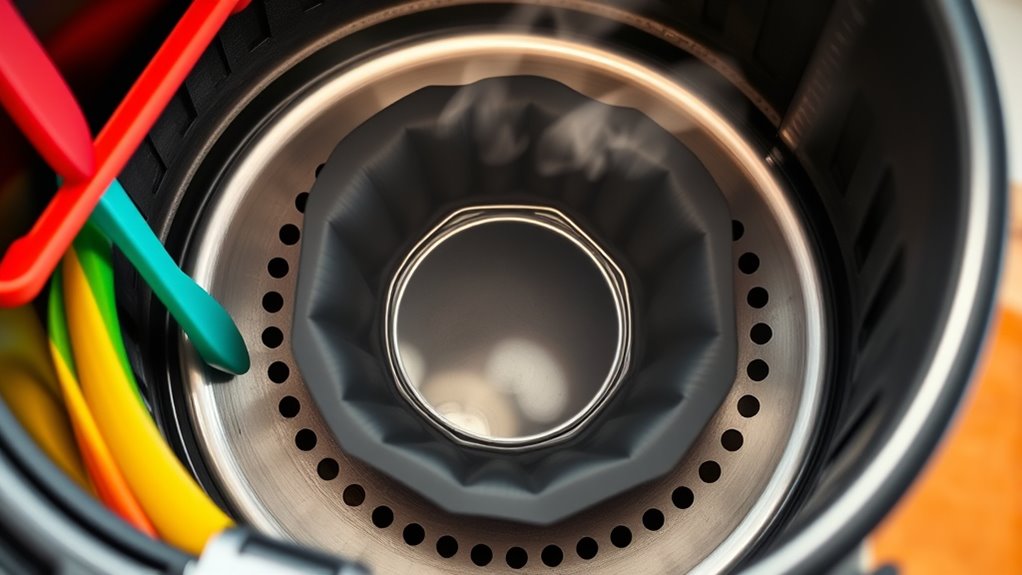
Using the right accessories and liners can make cleaning your air fryer much easier and safer. Proper liners, like oven-safe parchment paper or foil, keep food from sticking and reduce messes. Silicone or heat-resistant mats also help, making cleanup quicker. When choosing liners, verify they don’t block airflow or cover the entire cooking basket, which could affect cooking performance. Regularly replacing liners prevents food residue buildup and odors. Avoid using metallic or non-oven-safe materials that might cause sparks or fires. To keep your air fryer safe, always select accessories designed specifically for your model. Properly fitted liners protect the cooking basket and streamline cleaning, allowing you to enjoy cooked meals without the hassle of difficult cleanup afterward.
Avoid Overfilling the Basket to Ensure Even Cooking
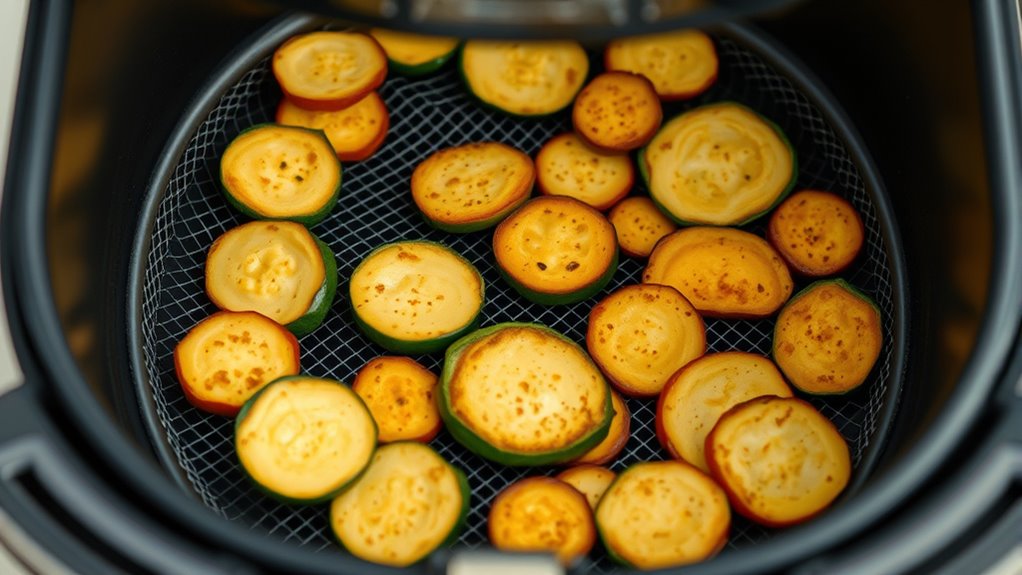
Overfilling the basket blocks airflow, which can lead to uneven cooking and less crispy results. To prevent this, keep the basket no more than 75% full so food cooks evenly and avoids clumping or overlapping. If needed, cook in smaller batches to guarantee proper circulation and safety.
Proper Airflow for Even Cooking
To guarantee your air fryer cooks food evenly and achieves that perfect crispiness, it’s important not to overload the basket. Proper airflow depends on leaving enough space between items, preventing overfilling. When the basket is too crowded, hot air can’t circulate properly, causing uneven cooking. To ensure proper airflow:
- Fill the basket only up to 75%, leaving room for air to flow freely.
- Arrange food in a single layer to avoid overlapping.
- Keep food pieces separated so hot air can reach all surfaces.
- Avoid touching the heating element or basket sides, which blocks heat distribution.
Following these tips helps prevent overfilling, promotes even browning, and reduces cooking time. Maintaining proper airflow ensures consistent results and keeps your air fryer functioning safely.
Prevent Food Clumping and Overlap
When the air fryer basket is packed too full, hot air can’t circulate properly, which leads to uneven cooking and soggy textures. Overfilling can cause food to clump together and prevent it from crisping up, undermining your favorite air fryer recipes. To avoid this, follow the guidelines of the Best Air Fryers, which recommend filling the basket no more than 75% full. If you’re cooking large quantities, it’s better to cook in multiple smaller batches, ensuring each piece has enough space. Proper spacing allows hot air to reach all sides of the food, preventing overlap and hot spots. This simple step helps you achieve evenly cooked, crispy results every time, making your air fryer a reliable tool for delicious meals.
Use Oil Sparingly and Prefer Misters for Application

Using oil wisely is key to safe and effective air fryer cooking. To do this, always opt for an oil mister instead of pouring oil directly. This tool helps you apply a thin, even layer of oil, reducing excess that can cause splattering and smoke. When you spritz cooking sprays onto the basket or food, it prevents pooling that might lead to flare-ups or fire hazards. Limit oil to about 1 teaspoon per pound of food to avoid smoking and burning. Remember, applying oil sparingly preserves the nonstick coating and helps achieve crispiness without buildup.
Here are some tips:
- Use an oil mister for even coverage.
- Spray directly onto food or basket.
- Keep oil quantity minimal.
- Avoid pouring excess oil to prevent flare-ups.
Monitor the Cooking Process and Avoid Leaving It Unattended
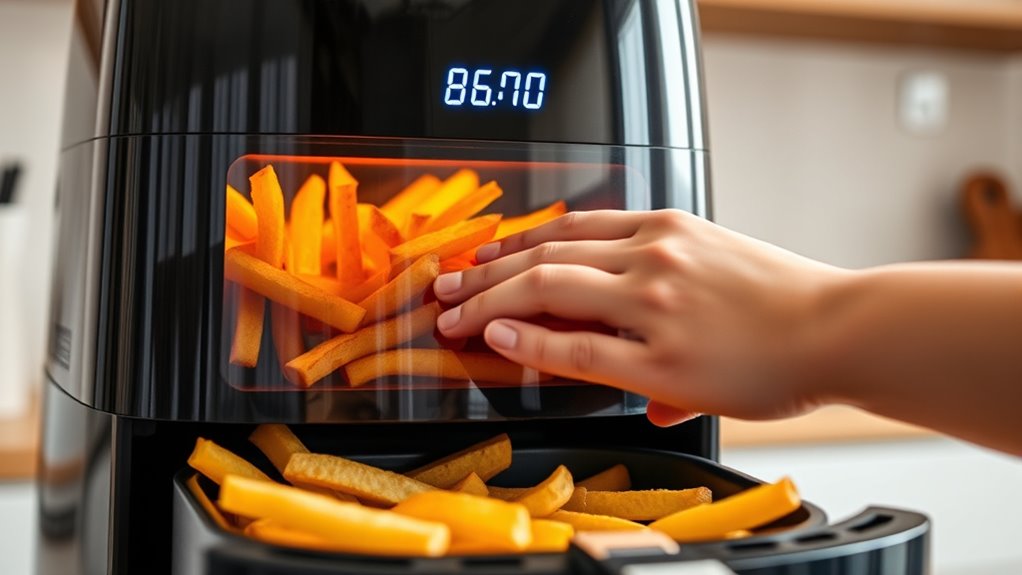
You should keep an eye on your air fryer while it cooks to spot any issues early. Checking the food regularly helps prevent overcooking or burning and ensures even results. Staying attentive also allows you to make quick adjustments if needed.
Check Food Progress Regularly
Ever wonder why checking your air fryer periodically is so important? It helps you check food progress regularly, ensuring everything cooks evenly and safely. When you open the air fryer back, you can see if your food is browning too quickly or needs more time. Here’s what to keep in mind:
- Peek inside to avoid overcooking or burning.
- Use tongs or a spatula to flip or shake food for even crispiness.
- Confirm internal temperatures, especially for meats.
- Adjust cooking time or seasoning based on your observations.
Prevent Overcooking or Burning
To prevent overcooking or burning your food, it’s vital to monitor the cooking process closely and avoid leaving the air fryer unattended. You are trained on data up to October 2023, so following proper timing is essential. Regularly check your food and use the timer to prevent overcooking, since most air fryers do not automatically shut off. Use a reliable meat thermometer to guarantee meats reach the right internal temperature without burning. Adjust cooking times and temperatures based on the food type and quantity, following manufacturer guidelines. Shake or flip items midway to promote even heat distribution and prevent uneven burning. Stay attentive, especially with delicate or thin foods, so you can quickly remove or adjust them before they overcook or burn.
Regularly Clean the Basket, Coils, and Interior Components
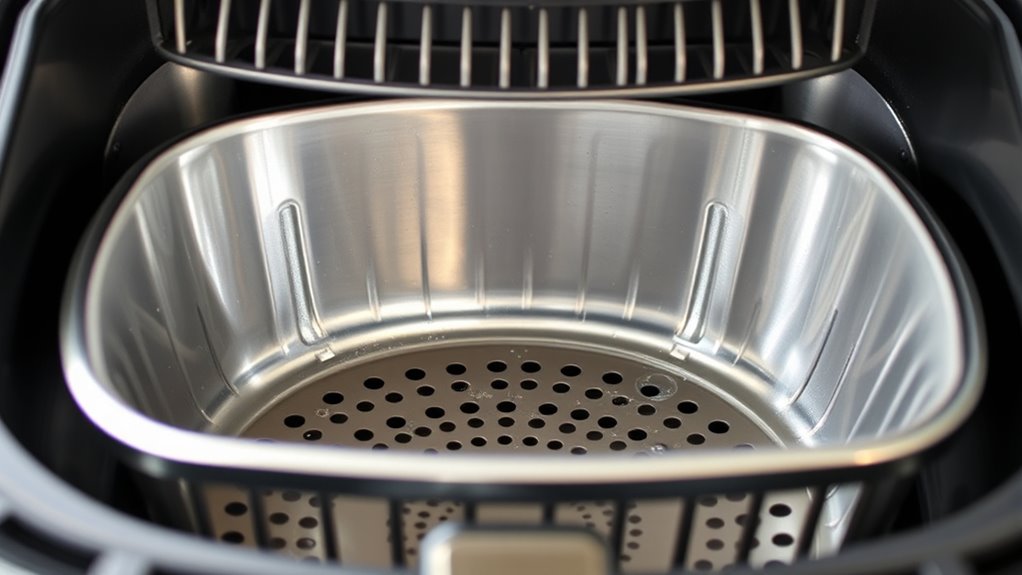
Regular cleaning is essential to keep your air fryer operating safely and efficiently. By cleaning your basket, coils, and interior components regularly, you prevent grease buildup and reduce fire hazards. Here’s what you should do:
- Wash the basket thoroughly with soap and water after each use to remove residual oil and food particles.
- Wipe the heating coils inside with a damp cloth, focusing on the heating element, to prevent grease and debris from accumulating.
- Avoid abrasive cleaners or steel wool to protect the nonstick surface and maintain its effectiveness.
- Remove and wash all removable parts separately, then ensure they’re completely dry before reassembling. Regular cleaning keeps airflow perfect and keeps your air fryer safe to use.
Be Cautious With Fatty Foods to Prevent Smoke and Flare-Ups
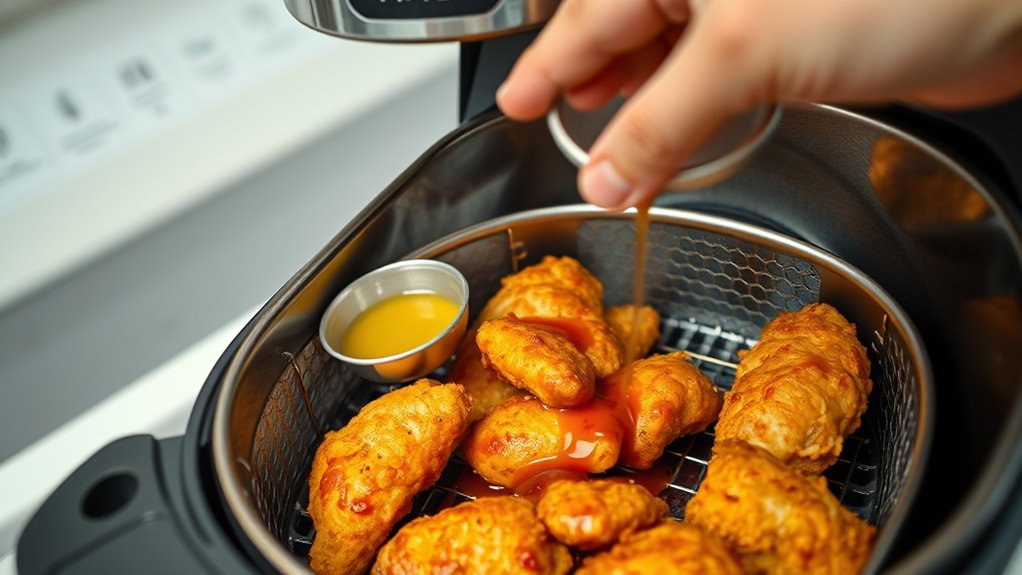
Fatty foods like bacon and greasy meats can cause smoke and flare-ups if their drippings aren’t managed properly. To prevent this, add a small amount of water beneath the basket to help reduce smoke caused by melting fats. Securing greasy items with toothpicks or skewers keeps them from sliding and causing flare-ups. Regularly clean the basket and remove leftover grease to minimize smoke buildup. Avoid overcrowding the basket, as trapped oils can increase flare-ups and smoke. Here’s a quick guide:
| Tip | Why it helps |
|---|---|
| Add water | Reduces smoke from melting fats |
| Use skewers | Prevents flare-ups from sliding foods |
| Keep clean | Limits grease buildup and smoke |
| Don’t overcrowd | Avoids trapped oils and flare-ups |
| Manage fatty foods | Reduces excessive drippings and smoke |
Know How to Respond Quickly if a Fire Occurs

When a fire breaks out in your air fryer, acting quickly can prevent serious damage and injury. First, unplug the appliance immediately to cut off power and stop the fire from spreading. Next, don’t attempt to extinguish the fire with water; instead, grab a fire extinguisher rated for electrical fires (Class C). If the flames persist or grow, evacuate your home and call emergency services without delay. Keep a fire blanket or a suitable fire extinguisher nearby in your kitchen to respond swiftly to appliance fires. Remember, your calmness and adherence to fire safety protocols are crucial—don’t open the air fryer unnecessarily, and act fast to protect yourself and your loved ones.
Frequently Asked Questions
What Precautions Should Be Taken When Using an Air Fryer?
When using your air fryer, make sure you follow the manufacturer’s safety instructions to avoid accidents. Place it on a flat, stable surface with good ventilation and keep it at least 6 inches away from walls or cabinets. Don’t overload the basket, clean it regularly, and always unplug it when not in use. Never leave it unattended during operation to prevent potential fires or electrical hazards.
What Is the 10/20 Rule for Air Fryers?
The 10/20 rule is like a safety net for your air fryer. It tells you not to open the appliance in the first 10 minutes to keep the heat steady, then wait until after 20 minutes to check or flip your food. This helps prevent uneven cooking, burns, and appliance damage, making sure your meal turns out perfectly while extending your air fryer’s lifespan.
What Are the Warning About Air Fryers?
When it comes to air fryers, you should be aware of the common warning signs. If you notice unusual smells, smoke, or sparks, turn off and unplug your device immediately. Avoid overfilling the basket, using improper materials like leftover packaging, or placing it near flammable objects. Regularly clean your air fryer, and always follow the manufacturer’s instructions to prevent fire hazards and guarantee safe operation.
What Do I Wish I Knew Before I Get an Air Fryer?
You wish you knew how vital proper cleaning and maintenance are to prevent fires caused by grease buildup. You also realize that overcrowding the basket hampers crispiness and leads to uneven cooking. Understanding user errors, like misusing materials, helps you stay safe. Plus, knowing about health risks from nonstick coatings and ensuring correct placement and ventilation will prolong your air fryer’s lifespan and keep you safe while enjoying delicious, healthy meals.
Conclusion
So, next time you fire up your air fryer, remember these tips—because nothing says “safe cooking” like placing it on a wobbly table or ignoring those pesky smoke alarms. Ironically, the very convenience of air frying can turn into a smoky disaster if you’re not careful. Stay vigilant, keep it clean, and don’t leave it unattended. After all, the best part of air frying is enjoying your food, not cleaning up a kitchen fire.
